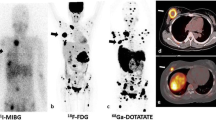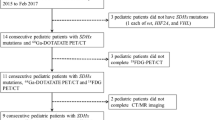Abstract
Background
Pheochromocytomas are rare tumors of chromaffin cells for which the optimal management is surgical resection. Precise diagnosis and localization may be elusive. We evaluated whether positron emission tomography (PET) scanning with the combination of [18F]fluorodeoxyglucose (FDG) and the norepinephrine analogue [11C]metahydroxyephedrine (mHED) would allow more exact diagnosis and localization.
Methods
Fourteen patients with suspected pheochromocytoma were evaluated by anatomical imaging (computed tomography or magnetic resonance imaging) and [131I]metaiodobenzylguanidine (MIBG) planar imaging. PET imaging was performed by using mHED with dynamic adrenal imaging, followed by a torso survey and FDG with a torso survey. Images were evaluated qualitatively by an experienced observer.
Results
Eight patients had pathology-confirmed pheochromocytoma. Of the other six, two patients had normal adrenal tissue at adrenalectomy, and the other four had subsequent clinical courses inconsistent with a diagnosis of pheochromocytoma. In four of eight patients with pheochromocytoma, MIBG failed to detect one or more sites of pathology-confirmed disease. The mHED-PET detected all sites of confirmed disease, whereas FDG-PET detected all sites of adrenal and abdominal disease, but not bone metastases, in one patient. MIBG and FDG-PET results were all negative in the six patients without pheochromocytoma. One patient with adrenal medullary hyperplasia had a positive mHED-PET scan. PET scanning aided the decision not to operate in three of six patients. The resolution of PET functional imaging was superior to that of MIBG.
Conclusions
PET scanning for pheochromocytoma offers improved quality and resolution over current diagnostic approaches. PET may significantly influence the clinical management of patients with a suspicion of these tumors and warrants further investigation.





Similar content being viewed by others
References
Lenders JW, Pacak K, Walther MM, et al. Biochemical diagnosis of pheochromocytoma: which test is best? JAMA 2002;287:1427–34
Neumann HP, Bausch B, McWhinney SR, et al. Germ-line mutations in nonsyndromic pheochromocytoma. N Engl J Med 2002;346:1459–66
Dluhy RG. Pheochromocytoma—death of an axiom. N Engl J Med 2002;346:1486–8
Miskulin J, Shulkin BL, Doherty GM, et al. Is preoperative iodine 123 meta-iodobenzylguanidine scintigraphy routinely necessary before initial adrenalectomy for pheochromocytoma? Surgery 2003;134:918–22; discussion 922–3
Wang W, Larson SM, Fazzari M, et al. Prognostic value of [18F]fluorodeoxyglucose positron emission tomographic scanning in patients with thyroid cancer. J Clin Endocrinol Metab 2000;85:1107–13
Hoegerle S, Nitzsche E, Altehoefer C, et al. Pheochromocytomas: detection with 18F DOPA whole body PET—initial results. Radiology 2002;222:507–12
Pacak K, Eisenhofer G, Carrasquillo JA, et al. 6-[18F]fluorodopamine positron emission tomographic (PET) scanning for diagnostic localization of pheochromocytoma. Hypertension 2001;38:6–8
Pacak K, Eisenhofer G, Carrasquillo JA, et al. Diagnostic localization of pheochromocytoma: the coming of age of positron emission tomography. Ann N Y Acad Sci 2002;970:170–6
Shulkin BL, Thompson NW, Shapiro B, et al. Pheochromocytomas: imaging with 2-[fluorine-18]fluoro-2-deoxy-D-glucose PET. Radiology 1999;212:35–41
Shulkin BL, Wieland DM, Schwaiger M, et al. PET scanning with hydroxyephedrine: an approach to the localization of pheochromocytoma. J Nucl Med 1992;33:1125–31
Trampal C, Engler H, Juhlin C, et al. Pheochromocytomas: detection with 11C hydroxyephedrine PET. Radiology 2004;230:423–8
Schwaiger M, Kalff V, Rosenspire K, et al. Noninvasive evaluation of sympathetic nervous system in human heart by positron emission tomography. Circulation 1990;82:457–64
Rosenspire KC, Haka MS, Van Dort ME, et al. Synthesis and preliminary evaluation of carbon-11-meta-hydroxyephedrine: a false transmitter agent for heart neuronal imaging. J Nucl Med 1990;31:1328–34
Shulkin BL, Wieland DM, Baro ME, et al. PET hydroxyephedrine imaging of neuroblastoma. J Nucl Med 1996;37:16–21
Hamacher K, Coenen HH, Stocklin G. Efficient stereospecific synthesis of no-carrier-added 2-[18F]-fluoro-2-deoxy-D-glucose using aminopolyether supported nucleophilic substitution. J Nucl Med 1986;27:235–8
Kalady MF, McKinlay R, Olson JA Jr, et al. Laparoscopic adrenalectomy for pheochromocytoma. A comparison to aldosteronoma and incidentaloma. Surg Endosc 2004;18:621–5
Kim AW, Quiros RM, Maxhimer JB, et al. Outcome of laparoscopic adrenalectomy for pheochromocytomas vs aldosteronomas. Arch Surg 2004;139:526–9; discussion 529–31
Jaroszewski DE, Tessier DJ, Schlinkert RT, et al. Laparoscopic adrenalectomy for pheochromocytoma. Mayo Clin Proc 2003;78:1501–4
Ilias I, Yu J, Carrasquillo JA, et al. Superiority of 6-[18F]-fluorodopamine positron emission tomography versus [131I]-metaiodobenzylguanidine scintigraphy in the localization of metastatic pheochromocytoma. J Clin Endocrinol Metab 2003;88:4083–7
Furuta N, Kiyota H, Yoshigoe F, et al. Diagnosis of pheochromocytoma using [123I]-compared with [131I]-metaiodobenzylguanidine scintigraphy. Int J Urol 1999;6:119–24
Acknowledgments
The authors thank Joanne Wells for help with the time course data and Dr. James Caldwell for the initial studies that allowed comparison with normal adrenals. Supported by National Institutes of Health grants P01 CA042045 and RO1 HL50239.
Author information
Authors and Affiliations
Corresponding author
Rights and permissions
About this article
Cite this article
Mann, G.N., Link, J.M., Pham, P. et al. [11C]Metahydroxyephedrine and [18F]Fluorodeoxyglucose Positron Emission Tomography Improve Clinical Decision Making in Suspected Pheochromocytoma. Ann Surg Oncol 13, 187–197 (2006). https://doi.org/10.1245/ASO.2006.04.022
Received:
Accepted:
Published:
Issue Date:
DOI: https://doi.org/10.1245/ASO.2006.04.022




